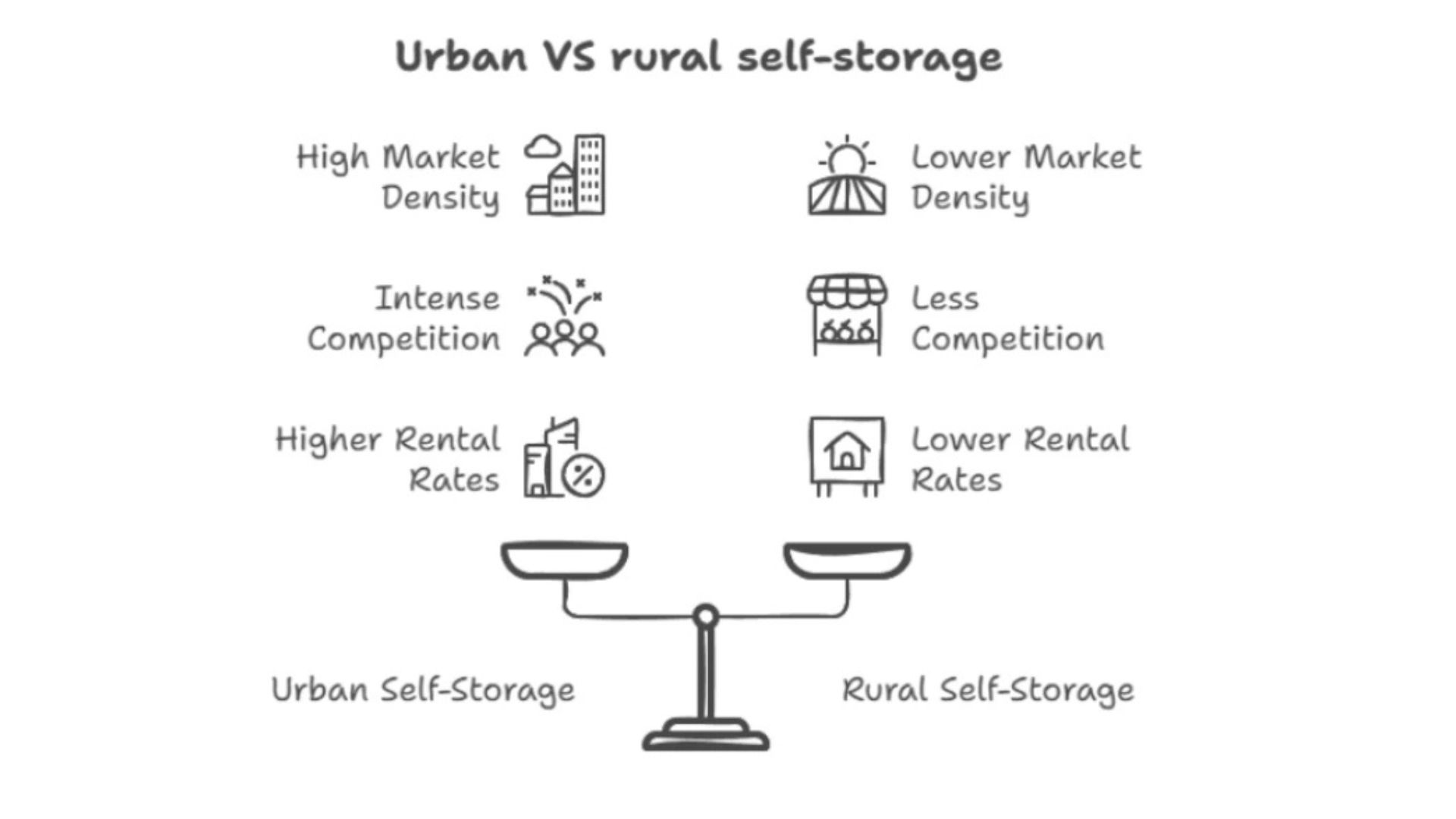You really can't miss it these days, can you? The self-storage facilities industry is absolutely booming. Just drive down almost any street in the country, and chances are you'll see new facilities popping up, or existing ones expanding. It's a clear sign of just how much this sector has grown and how resilient it's proven to be. As an investment, it's drawing interest from everyone - seasoned real estate investors with decades under their belt, all the way to folks making their very first foray into property investment. But the fundamental question I often hear, and it's a good one, is this: Where does the real profit potential actually lie? Is it nestled in the densely packed, fast-moving urban centers, or out in the more wide-open spaces of rural America?
Having spent [Insert Your Number] years guiding clients through self-storage investments, working across both urban and rural landscapes, I've developed a real feel for the subtle differences, the little nuances that truly drive ROI in these two distinct kinds of markets. My aim with this article is to get straight to the point, cutting through some of the general hype you might encounter. I want to give you a clear, well-reasoned comparison of urban versus rural self-storage opportunities. More importantly, I hope to offer you practical, actionable insights that you can genuinely use. Insights that will help you make truly informed investment decisions and, ultimately, maximize your self-storage profitability. Consider this piece your personal insider's look, a guide to help you confidently navigate the self-storage landscape and choose the location type that genuinely aligns best with your specific investment objectives.
Understanding the Self-Storage Landscape: Urban vs. Rural
It's important first to define these two environments, as they operate quite differently.
Defining the Urban Self-Storage Market
The defining characteristic of the urban self-storage market is undoubtedly density - density of people, but also density of existing storage options, meaning competition. Think about those towering apartment buildings, the endless bustle of businesses, and the simple, undeniable reality of limited space for... well, for everything. That paints a pretty good picture of your typical urban customer base. Facilities here largely serve apartment dwellers who are likely short on space or perhaps downsizing. Businesses are a huge segment, needing storage for inventory, important documents, or seasonal items. And you find a lot of individuals going through major life events - moving house (often to a smaller place!), undertaking renovations where literally everything needs to be packed away for a while, or managing inherited property and its contents. Competition, as you can imagine, is really fierce. You'll see numerous facilities packed fairly closely together, all vying for attention in a limited geographic area. This competition, combined with the premium cost of land and space, naturally leads to higher rental rates compared to rural areas. Urban sprawl is also a significant factor; as populations spill out into less central but still densely populated suburban areas, that outward movement continues feed the demand for storage in those expanding zones.
Defining the Rural Self-Storage Market
In stark contrast, the rural self-storage market moves at a different pace entirely. Picture expansive farmlands, established, often multi-generational communities, and a general sense of a slower rhythm of life. Out here, customer profiles tend to differ. You often see homeowners needing somewhere to store seasonal items, say, garden equipment over the winter, or even vehicles like boats or RVs that simply can't be kept at home easily. Farmers are a key demographic, requiring storage for supplies or machinery during off-seasons. Seasonal residents, perhaps those with vacation properties, frequently need secure storage for their belongings between visits. And, honestly, many individuals are simply looking for more affordable long-term storage solutions, something that's easier to find when land is less expensive. You'll encounter much less direct competition; perhaps just a handful of facilities serving a much larger geographic area. Consequently, rental rates are generally lower, reflecting both the lower cost of living and the readily available land. Rural facilities also often feel more integrated into their local communities, and their success can be quite closely tied to the health of that local economy.
ROI Factors: Deconstructing the Urban Self-Storage Model
Let's break down the revenue and cost sides in urban settings.
Revenue Drivers in Urban Areas
The main drivers of revenue for an urban self-storage facility are high occupancy rates and the ability to charge those premium rental rates. Thanks to the limited space and a constant stream of new residents and businesses, urban facilities very frequently operate at or near full capacity. This allows operators to command significantly higher rental rates than their rural counterparts - it's not uncommon for rates to be 20-30% higher in dense city locations. Beyond simply renting units, smart urban operators are adept at leveraging ancillary services to boost revenue further. Think selling moving supplies, offering tenant insurance, providing truck rental services, or even packing services. Effective revenue management - using real-time data to adjust pricing based on demand - is crucial to maximizing income in such a dynamic environment.
Cost Considerations in Urban Areas
However, while the revenue potential in urban areas is high, the costs are equally significant. Land acquisition is almost always the biggest hurdle; prices in prime urban spots can be astronomical. Construction costs are also elevated, partly due to the need for multi-story buildings (vertical construction) to maximize space on expensive land, which is simply more complex and costly than single-story builds. Beyond these initial capital expenses, ongoing operating costs are typically higher. Property taxes are usually much higher, and you need robust security measures - better surveillance, maybe on-site staff, controlled access - to mitigate higher crime risks, which significantly adds to expenses. Marketing also requires a more sophisticated, often multi-channel effort to reach a dense but diverse urban population effectively and stand out from the competition.
ROI Factors: Deconstructing the Rural Self-Storage Model
Now, let's look at the economics in rural areas.
Revenue Drivers in Rural Areas
Revenue generation in rural self-storage works differently. While occupancy rates might be lower overall than in a bustling city, they often show impressive stability, providing a consistent, reliable income stream. Rental rates are lower, which aligns with the lower cost of living and less competition. However, smart rural operators capitalize on seasonal demand dips and surges. A place near farmland might see demand spike during harvest season; one near a lake community will fill up in summer. Customer loyalty is incredibly important in rural markets. Building good relationships and providing excellent service often translates directly into longer rental periods and invaluable word-of-mouth referrals. Revenue management is still relevant, though perhaps involves more modest, gradual rate increases over time as the local community grows and awareness of self-storage increases.
Cost Considerations in Rural Areas
One of the biggest advantages of rural self-storage is the lower entry cost. Land acquisition is dramatically cheaper than in urban areas; you can get larger parcels for a fraction of the price. Construction is also typically less expensive, usually involving simpler, single-story designs. Operating expenses are generally lower too, with lower property taxes and usually fewer stringent, costly security requirements. However, maintenance can be a bigger factor, especially in areas with challenging weather. Snow removal, landscaping across a larger property, general upkeep - these can add up. Marketing needs to be tailored locally; think local newspapers, community events. And don't forget the internet - people in rural areas often travel further, so they frequently search online for solutions like storage. A good website is vital.
Comparative ROI Analysis: Urban vs. Rural - Which Wins?
So, the core question: Which offers better ROI? Urban or rural? The honest truth, based on what I've seen over the years, is there's no single definitive answer that fits everyone. The best choice depends heavily on your specific investment goals, your comfort with different levels of risk, and your available capital. Saying one definitively "wins" wouldn't be accurate or helpful.
Urban self-storage offers the potential for higher returns, driven by those premium rates and high occupancy. But this absolutely comes with significantly higher upfront capital requirements and higher operating expenses. In my experience, well-run urban facilities can achieve ROIs in the 8-12% range, but it requires navigating highly competitive markets and managing costs meticulously. Selling the land later at a profit is also a potential boost to ROI in cities.
Rural self-storage generally presents a lower-risk, perhaps more stable investment. While per-unit revenue is lower, the substantially reduced costs for land and construction can result in very attractive ROIs. I've seen successful rural projects consistently generate returns in the 6-10% range, offering a reliable income stream with less volatility than urban markets. Their value tends to be more tied to the income stream generated. So, the "winner" really hinges on your strategy: high-growth potential with higher risk, or steady, reliable income with lower risk? Both can be profitable; the key is understanding each market's specific dynamics and aligning your approach. Keep in mind, these are ranges; market conditions and management quality will always influence actual results.
Mitigating Risks and Maximizing Returns: Expert Strategies
Regardless of location, certain strategies can boost your chances of success.
Optimizing Urban Self-Storage ROI
To maximize ROI in the competitive urban market, you need a multi-pronged approach. Offer premium units - climate-controlled or larger sizes for businesses - to command higher rates. Use sophisticated revenue management, dynamic pricing based on real-time demand. Targeted marketing through online ads, social media, and local partnerships is crucial to stand out. And operational efficiency is paramount; streamlining processes, controlling energy use, minimizing waste - I've seen clients improve ROI by 2-3% just through better operations.
Optimizing Rural Self-Storage ROI
In rural markets, success often comes down to building strong community relationships. Customer retention is key - provide excellent, personalized service. Cost management is critical too; watch expenses, negotiate with suppliers, look for energy savings. Participate in local events; support community groups - it builds reputation and attracts local customers. Local marketing is essential - community papers, local radio, targeted online efforts. Remember, in rural areas, good old word-of-mouth is often your most powerful marketing tool. Nurturing those relationships pays off long-term.
Conclusion
Both urban and rural self-storage markets offer compelling investment opportunities, each with their distinct pros and cons. As we've discussed, urban facilities offer higher revenue potential but demand significant capital and skill in competitive environments. Rural facilities offer stability and lower entry costs, rewarding operators who build strong local ties and manage expenses diligently.
Ultimately, the "best" choice is entirely personal, depending on your situation and what you hope to achieve with your investment. This is where having expert guidance, someone who understands the nuances of both markets, can make a real difference. I'm happy to help you sort through these complex decisions. Please feel free to contact me to discuss your specific goals and develop a tailored strategy to help you unlock your self-storage investment potential! Let's work together to turn your self-storage ambitions into a profitable reality.





